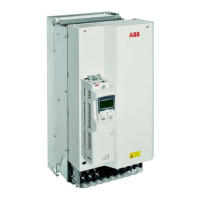Planning the cabinet installation
38
Arranging the grounding inside the cabinet
Arrange proper grounding for any cross-members or shelves on which components
are mounted:
• Leaving the component connecting surfaces unpainted will form a proper
grounding contact to cabinet frame.
• The drive module will be grounded to the cabinet frame via its fastening screws.
Selecting busbar material and preparation of the joints
If planning the use of busbars, note the following:
• Tin-plated copper is recommended. Aluminium can also be used.
• For the joints of aluminium busbars, the oxide layer must be removed and
suitable anti-oxidant joint compound applied.
Tightening torques
Apply the following torques to grade 8.8 screws (with or without joint compound) that
tighten electric contacts.
Planning the fastening of the cabinet
Note the following when planning the fastening of the cabinet:
• The cabinet must be fastened to the floor from front and back.
• If fastening at the back is not possible or the cabinet will be exposed to vibration,
the cabinet must be fastened at the top to the rear wall/roof.
WARNING! Do not fasten the cabinet by electric welding. ABB does not assume any
liability for damages caused by electric welding as the welding circuit may damage
electronic circuits in the cabinet.
Screw size Torque
M5 3.5 N·m (2.6 lbf·ft)
M6 9 N·m (6.6 lbf·ft)
M8 20 N·m (14.8 lbf·ft)
M10 40 N·m (29.5 lbf·ft)
M12 70 N·m (52 lbf·ft)
M16 180 N·m (133 lbf·ft)

